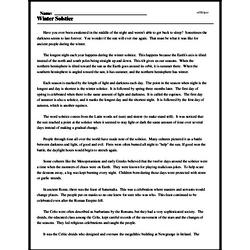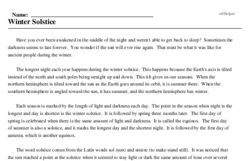Winter Solstice
Winter Solstice
Reading Comprehension for December 21
Have you ever been awakened in the middle of the night and weren't able to get back to sleep? Sometimes the darkness seems to last forever. You wonder if the sun will ever rise again. That must be what it was like for ancient people during the winter.
The longest night each year happens during the winter solstice. This happens because the Earth's axis is tilted instead of the north and south poles being straight up and down. This tilt gives us our seasons. When the northern hemisphere is tilted toward the sun as the Earth goes around its orbit, it is summer there. When the southern hemisphere is angled toward the sun, it has summer, and the northern hemisphere has winter.
Each season is marked by the length of light and darkness each day. The point in the season when night is the longest and day is shortest is the winter solstice. It is followed by spring three months later. The first day of spring is celebrated when there is the same amount of light and darkness. It is called the equinox. The first day of summer is also a solstice, and it marks the longest day and the shortest night. It is followed by the first day of autumn, which is another equinox.
The word solstice comes from the Latin words sol (sun) and sistere (to make stand still). It was noticed that the sun reached a point at the solstice when it seemed to stay light or dark the same amount of time over several days instead of making a gradual change.




